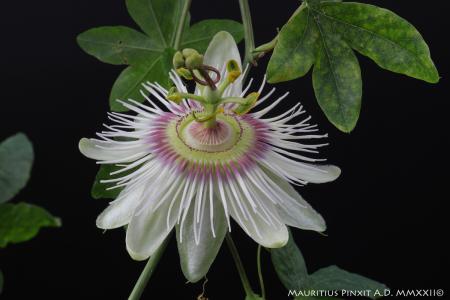
SUBGENUS: passiflora
SUPERSECTION: stipulata
SECTION: granadillastrum
GEOGRAPHICAL DISTRIBUTION OR ORIGIN:
Horticultural selection of P. caerulea.
MINIMUM TEMPERATURE: - 15 °C
IDEAL MINIMUM TEMPERATURE: 5 °C
ETYMOLOGY: Dedicated to Pierre Pomié, a well-known French collector.
NOTES: White flower cultivar with pink ring on the corona.
DESCRIPTION:
The Frenchman Pierre Pomié deserves the merit for having selected this particular variety of P. caerulea to which he gave his name.
It has large, very decorative flowers that resemble those of P. caerulea 'C. Eliott' in consistency and size. The petals and sepals, embellished with a light pink shade, are so shiny and brilliant they resemble porcelain.
The corona of filaments is almost completely white, except at the base where it is pink for about 6-7 mm. The flower thus displays a coloured ring against a white background.
The shape of the flowers is perfect thanks to the symmetrical five sepals and longer, wider petals than those of the typical species. The corona of filaments, also substantial and robust, has almost the same diameter as the corolla. However, it is sufficiently sparse not to obscure its beauty; indeed, the two structures integrate perfectly from an aesthetic point of view.
The mass of flowers, all rimmed in pink, produces an unusual picture. It is therefore recommended for those who want a rare and unusual, albeit very easy to cultivate, climber in the garden.
The hardiness and necessary cultivation rules are just like those required by other varieties of P. caerulea, even though the P. caerulea 'Pierre Pomié' is among the least invasive.
It blooms from late spring to autumn and, unlike the typical species, has the prerogative to do so even when still small. It is a unique sight to see small specimens of this climber, loaded with large buds ready to open and bloom one after the other, day after day. It also offers a scent that dissipates and attracts insects, greedy for nectar.
It requires a sunny position and has no particular soil preferences, growing in even dry and arid soils.
Propagation should be done only vegetatively in order not to
alter the genetic characteristics of the variety.